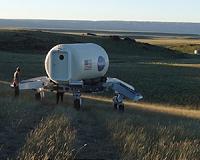 |
Washington DC (SPX) Sep 09, 2010 NASA's pioneering use of prize competitions and innovation challenges is a dramatic departure from government's traditional "business as usual." The agency's innovation and technology challenges include prizes that encourage independent teams to race to achieve bold goals - without any upfront government funding. NASA benefits from private sector investments many times greater than the cash value of prizes, and the agency only pays for results. "NASA prize competitions unlock the extraordinary, sometimes untapped potential of U.S. students, private companies of all sizes and citizen inventors," said NASA Chief Technologist Bobby Braun at NASA Headquarters in Washington. "These individuals and teams are providing creative solutions to NASA challenges while fostering new technology, new industries and innovation across the United States." NASA has a history of broad and successful experiences with prize challenges. The agency is a leader in government-sponsored competitions that solve problems to benefit the space program and nation. Since 2005, NASA has conducted 20 Centennial Challenges in six areas and awarded $4.5 million to 13 teams. Each challenge is managed by non-profit organizations in partnership with NASA. In July, NASA announced three new challenges and is seeking non-profit organizations to manage them. The challenges are: + The Nano-Satellite Launch Challenge is to place a small satellite into Earth orbit, twice in one week, for a prize of $2 million. The goals of this challenge are to stimulate innovations in low-cost launch technology and encourage commercial nano-satellite delivery services. + The Night Rover Challenge is to demonstrate a solar-powered exploration vehicle that can operate in darkness using its own stored energy. The prize purse is $1.5 million. The objective of this challenge is to stimulate innovations in energy storage technologies for extreme space environments, such as the surface of the moon, or for electric vehicles and renewable energy systems on Earth. + The Sample Return Robot Challenge is to demonstrate a robot that can locate and retrieve geologic samples from varied terrain without human control. This challenge has a prize purse of $1.5 million. The objective is to encourage innovations in automatic navigation and robotic technologies. NASA's Centennial Challenges program has an impressive track record for generating novel solutions from student teams, citizen inventors and entrepreneurial firms outside the traditional aerospace industry. NASA is putting the innovations to work, as the agency recently announced awards to two small aerospace firms for flight testing rocket vehicles based on designs that won prizes in the Lunar Lander Challenge. NASA's Green Flight Challenge offers $1.5 million for an aircraft with unprecedented fuel-efficiency. At least 10 teams are preparing to compete next summer in the challenge. Other agency challenges are focused on wireless power transmission and super-strong materials. In addition to the Centennial Challenges, NASA sponsors innovation challenges, posing problems via the Internet to people around the world. NASA uses open innovation platforms, or crowd sourcing, to take advantage of group power from outside the agency to help solve problems or to bring in new ideas. Current challenges seek innovative solutions to health and medical problems of astronauts living in space, the forecasting of solar storms and exercise equipment for crews aboard the International Space Station. Solutions are submitted in return for prizes or recognition by the space program. NASA recently inaugurated an employee challenge called NASA@Work. This collaborative problem-solving program will connect the collective knowledge of experts from around the agency using a private Web-based platform. NASA "challenge owners" can post problems for review by internal "solvers." The solvers who deliver the best innovative ideas will receive a NASA Innovation Award.
Share This Article With Planet Earth
Related Links NASA Centennial Challenges Space Tourism, Space Transport and Space Exploration News
 ATHLETE Rover Steps Up To Long Desert Trek
ATHLETE Rover Steps Up To Long Desert TrekPasadena CA (JPL) Sep 06, 2010 The ATHLETE rover, currently under development at NASA's Jet Propulsion Laboratory, Pasadena, Calif., is in the Arizona desert this month to participate in NASA's Research and Technology Studies, also known as Desert RATS. The desert tests offer a chance for a NASA-led team of engineers, astronauts and scientists from across the country to test concepts for future missions. NASA will demon ... read more |
|
| The content herein, unless otherwise known to be public domain, are Copyright 1995-2010 - SpaceDaily. AFP and UPI Wire Stories are copyright Agence France-Presse and United Press International. ESA Portal Reports are copyright European Space Agency. All NASA sourced material is public domain. Additional copyrights may apply in whole or part to other bona fide parties. Advertising does not imply endorsement,agreement or approval of any opinions, statements or information provided by SpaceDaily on any Web page published or hosted by SpaceDaily. Privacy Statement |